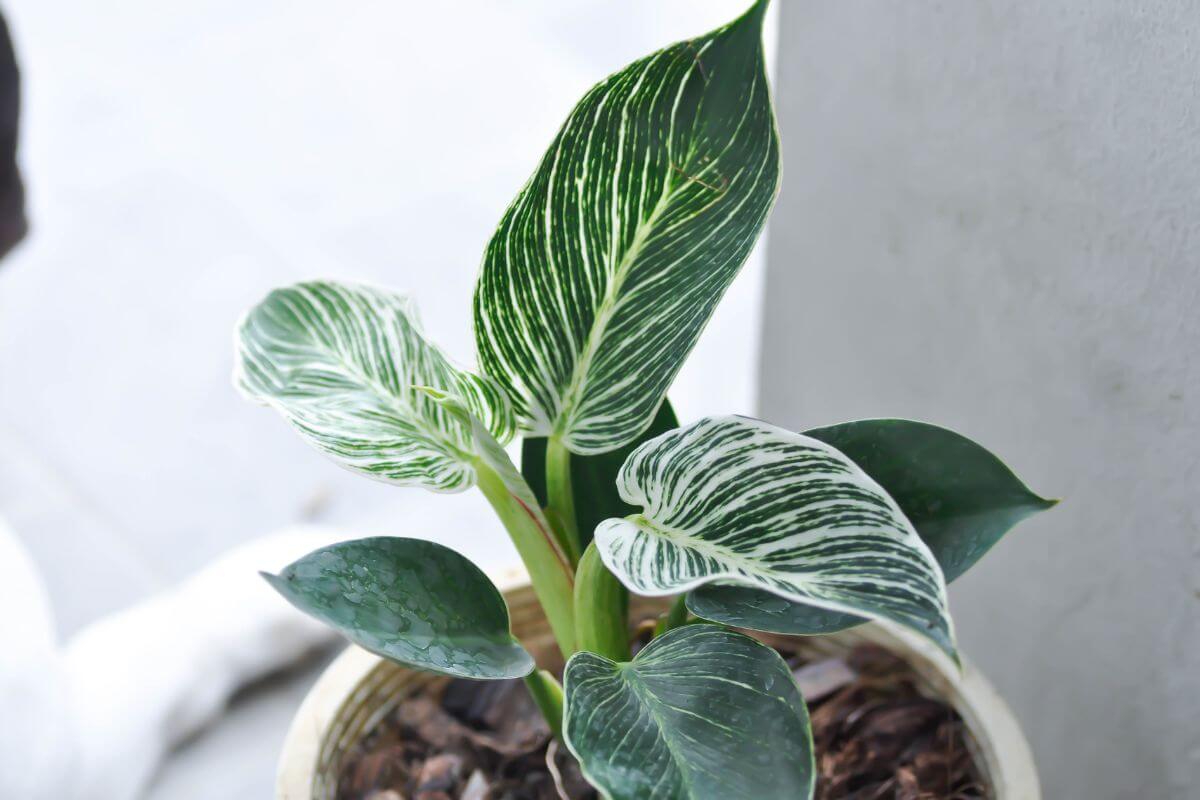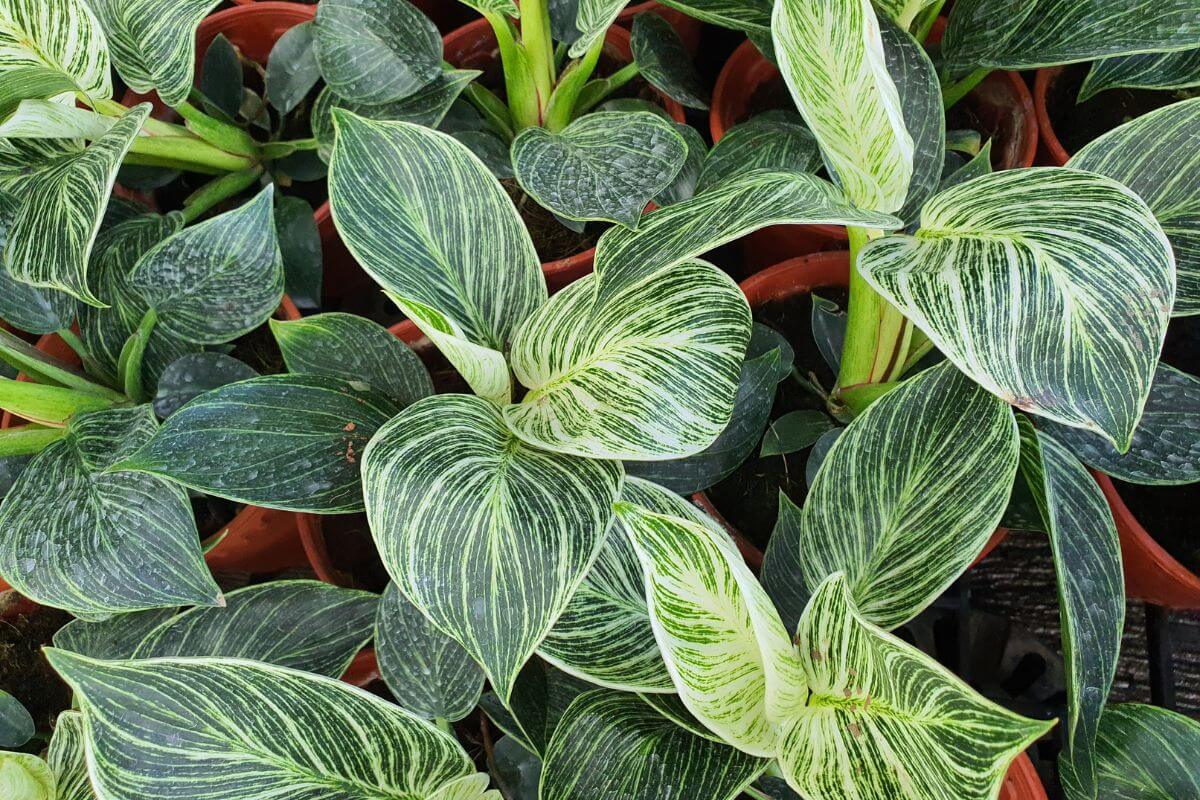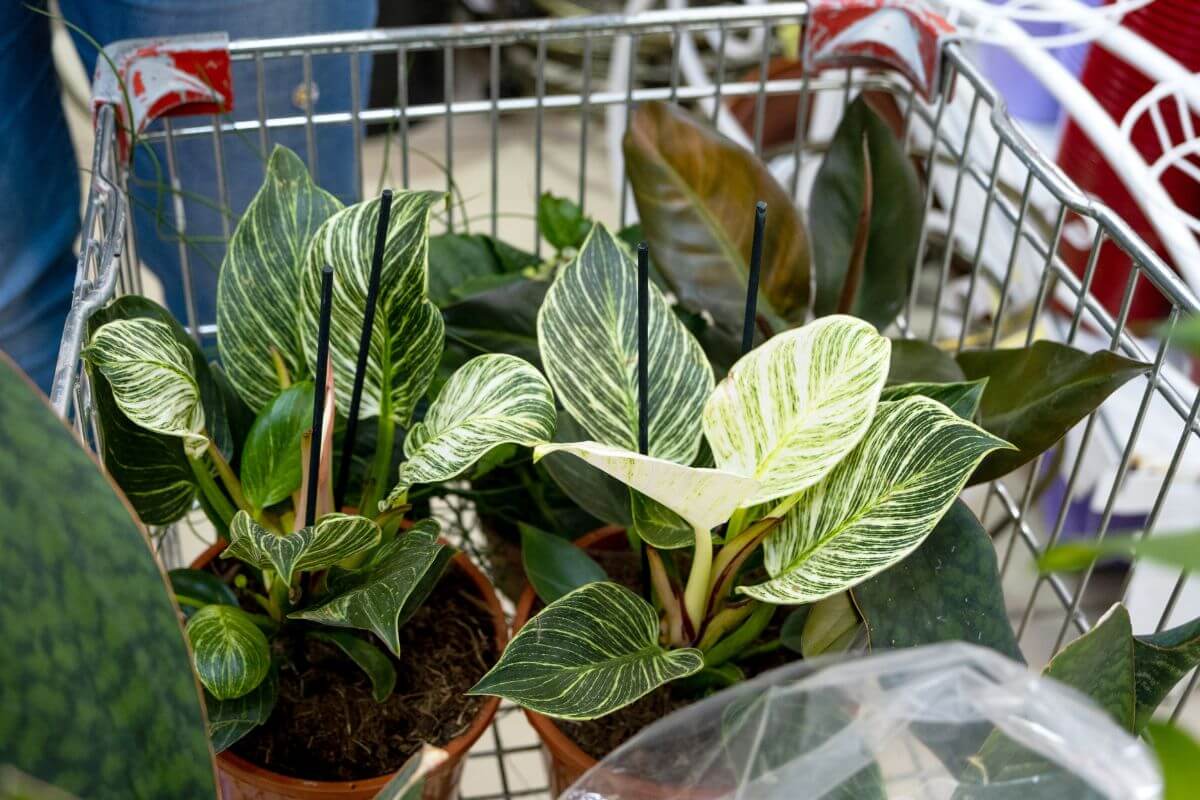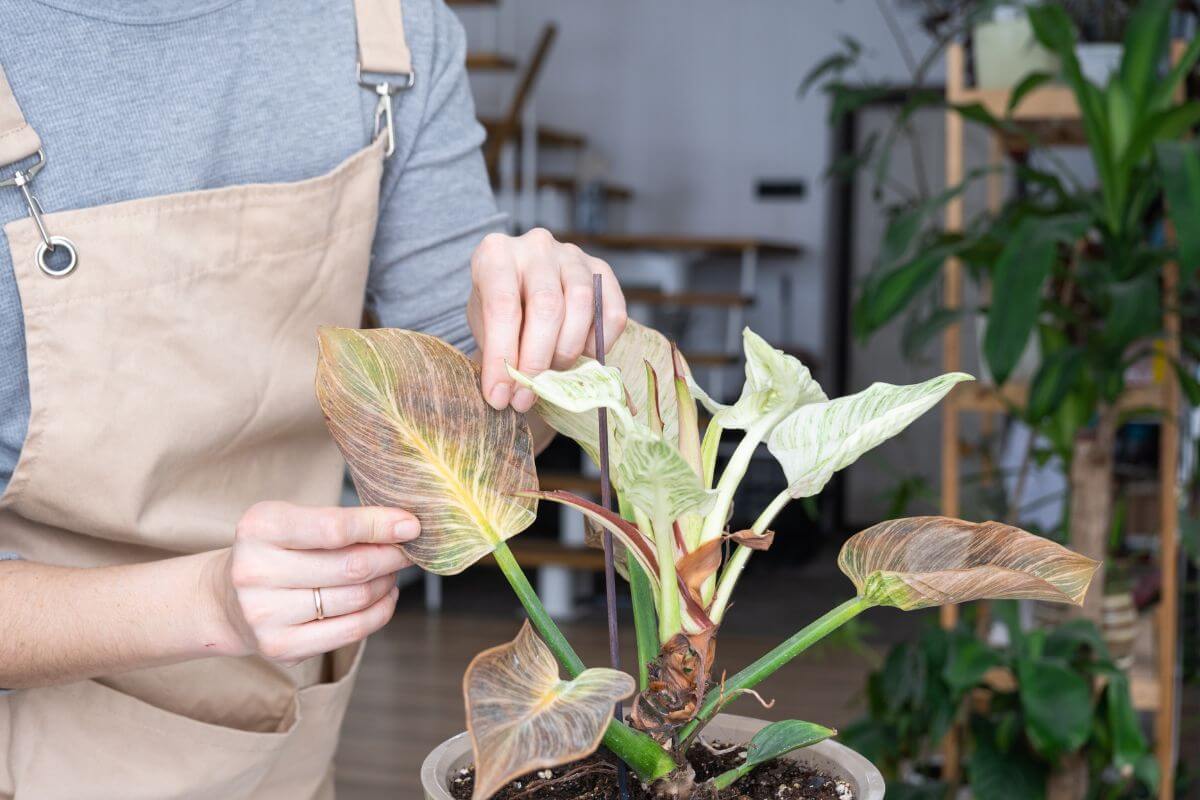The Philodendron Birkin is a captivating hybrid plant known for its stunning white variegation and heart-shaped leaves.
Named after the iconic Hermès purse, this houseplant adds a touch of elegance to any home or office space. Originally derived from the Philodendron Rojo Congo, the Birkin thrives in tropical conditions and is beloved for its unique beauty and moderate care requirements.
In this guide, you’ll discover essential tips for nurturing your Philodendron Birkin to ensure it flourishes in your indoor garden.
7 Key Takeaways on the Philodendron Birkin Plant
- The Philodendron Birkin, also known as Philodendron White Wave, features dark green leaves with white variegation.
- It thrives in bright, indirect sunlight and should be kept away from direct sunlight.
- Water when the top inch of soil feels dry, typically every 1-2 weeks during the growing season.
- Prefers humidity levels between 40% and 70%. Mist regularly to maintain moisture.
- Ideal temperature range is 65°F to 85°F (18°C to 29°C); avoid cold drafts.
- The plant is toxic to pets, causing irritation and gastrointestinal upset if ingested.
- Watch for pests like spider mites and mealybugs, and treat diseases like root rot promptly.
Overview of the Philodendron Birkin

The Philodendron Birkin is a new hybrid in the popular Philodendron family, named after the famous Hermès purse. This unique houseplant brightens up any home or office.
Also known as the Philodendron White Wave, it belongs to the Araceae family. As a hybrid, it doesn’t have a native habitat. It originated from a spontaneous mutation of the Philodendron Rojo Congo, another man-made cultivar.
The Philodendron is a tropical plant, with similar varieties found in northern South America.
Here’s an overview of the Philodendron Birkin’s physical characteristics:
| Characteristic | Details |
|---|---|
| Leaf Shape | Heart-shaped, with a glossy texture |
| Leaf Color | Dark green leaves with striking white striped variegation or cream variegation |
| Leaf Size | Typically 6 to 12 inches long |
| Growth Habit | Upright growth with a bushy appearance |
| Stems | Thick, sturdy, and green with a slight reddish tint |
| Mature Height | 2 to 3 feet tall in height when fully grown |
| Petiole | Long and sturdy, supporting the large leaves |
| Growth Rate | Moderate growth rate, especially in optimal conditions |
Various Birkins have been known to turn completely green and produce white foliage or even feature a spot of pink. Although it’s not a great climber, the Birkin will develop aerial roots and hook onto surfaces, especially textured ones.
- Read more: Guide to Plants With Aerial Roots
Philodendron Birkin Care Guide
The Philodendron Birkin is a stunning houseplant that requires specific care to thrive. This guide covers essential needs like light, water, and humidity to help your Birkin flourish. Follow these tips for a healthy and vibrant plant.
Philodendron Birkin Soil Requirements
The Birkin Philodendron likes loose, airy soil that is moist and well-draining. You may want to purchase an aroid soil mixture or blend your own potting mix.
Follow these steps for a homemade potting mix:
- Prepare Your Base – Start by blending 50% potting soil to create your foundation. This gives necessary nutrients and a strong framework for the plant.
- Add Moisture Retention – Add sphagnum moss to make up 25% of the mix. It helps retain moisture and keeps the soil from drying out too quickly.
- Improve Drainage – Add 25% orchid bark into the mix. This helps improve drainage, preventing waterlogging around the roots.
- Optional Mix Variations -If you don’t have available sphagnum moss and orchid bark, you can try 2/3 potting mix and one-third perlite for better aeration or 2/3 peat and one-third perlite to balance moisture retention and drainage.
- Choose a Pot – Use a plastic or terracotta pot with multiple drainage holes to allow excess water to escape.
Philodendron Birkin Light Requirements

The Philodendron Birkin thrives in bright, indirect sunlight, much like other tropical plants. It’s important to avoid direct sunlight, as it can scorch the leaves. If your Birkin has a lot of white in its leaf variegation, it will need brighter indirect light for healthy growth.
Tips for proper lighting:
- Position your Philodendron Birkin near windows to maximize light exposure.
- In winter, move the plant closer to the window to capture more light.
- During warmer months, place the plant farther from the window to prevent intense sunlight.
Remember, too little light can cause your Birkin to lose its variegation and impact its overall health.
Philodendron Birkin Water and Humidity Requirements
Proper water and humidity levels are essential for your Philodendron Birkin to thrive. Understanding how to meet these needs will help keep your plant healthy and vibrant. Let’s discuss the best practices for watering and maintaining humidity for your Birkin.
Water Requirements:
- Watering Frequency – Water your Philodendron Birkin when the top inch of soil feels dry. Typically, this means watering every 1 to 2 weeks during the growing season (spring and summer). In winter, let the soil dry out more before watering.
- Soil Moisture – Keep the soil moist but not soggy. Overwatering can cause root rot, so ensure good drainage.
Humidity Requirements:
- Ideal Humidity Levels – The Philodendron Birkin thrives in humidity levels between 40% and 70%. You can use a hygrometer to measure humidity.
- Humidity Maintenance – To maintain humidity, mist the plant occasionally, group it with other plants, or use a humidifier. Placing it in naturally humid areas, like kitchens or bathrooms, can also help.
Philodendron Birkin Temperature Requirements

Here are temperature recommendations and guidelines for your Philodendron Birkin:
| Temperature Requirement | Details |
|---|---|
| Ideal Temperature Range | 65°F to 85°F (18°C to 29°C) – Mimics the warm, tropical conditions of its origin. |
| Minimum Tolerance | Below 55°F (12°C) – Can stress and damage the plant; keep away from cold drafts and vents. |
| Indoor Conditions | Homes usually maintain around 70°F (20°C) – Suitable for the Birkin. Bring it inside at night if outdoors. |
Drafts can be a problem, too. Your Birkin should be protected from heating and air conditioning units and vents, and drafty windows, doorways, and corridors.
Philodendron Birkin Fertilizer Requirements
Feed your Philodendron Birkin once a month with a liquid fertilizer. The best time to do this is when you water the plant. A balanced 20-20-20 fertilizer diluted to half strength works well.
You can also use organic houseplant fertilizer, but it may work a bit slower. You can also add 10% of compost to potting soil when repotting. There’s no need to fertilize in the winter months during the plant’s dormant period.
How to Prune the Philodendron Birkin
Pruning your Philodendron Birkin is important for keeping it healthy and looking great. Follow this simple step-by-step guide to prune your plant effectively:
Steps to Prune Philodendron Birkin:
- Timing – Prune your Philodendron Birkin in spring or early summer when it is growing actively. This helps the plant recover quickly.
- Gather Tools – Use sharp, clean scissors or pruning shears to make neat cuts and avoid spreading diseases.
- Inspect the Plant – Check for yellowing, dead, or damaged leaves that need to be removed. Look for long, leggy stems that can be trimmed to encourage bushier growth.
- Make the Cuts: For Leaves – Cut dead or yellowing leaves close to the base of the stem, being careful not to harm the main stem. For Leggy Stems – Trim stems just above a leaf node (the point where a leaf connects to the stem) to encourage new growth.
- Remove Non-Variegated Growth – If you see any solid green growth, trim these sections to help the plant focus on growing variegated leaves.
- Clean Up – After pruning, remove any cuttings from around the plant to avoid pest problems and keep things tidy.
- Post-Pruning Care – Water the plant lightly if needed and make sure it gets enough light and humidity to help it recover.
Also, make sure to use sharp and sterile scissors when pruning. I use the Bypass Pruning Shears to make sure that the cuts are clean and precise which can reduce the risk of disease.
How to Repot the Philodendron Birkin

Repotting your Philodendron Birkin is important for its growth and health. Follow this step-by-step guide to repot your plant:
Steps to Repot Philodendron Birkin:
- Determine When to Repot – Watch for signs that your plant needs repotting, such as roots growing out of the drainage holes, roots forming a mat on the soil surface, or the soil drying out quickly, making you water more often.
- Choose the Right Pot – Pick a pot that is 1-2 inches larger in diameter than the current one. Make sure it has drainage holes to prevent water from building up.
- Prepare the Potting Mix – Use a well-draining potting mix designed for tropical plants. A mix of potting soil with perlite or orchid bark is great for ensuring proper drainage and air circulation.
- Water Before Repotting – Water your Philodendron Birkin well a day before repotting. This will help loosen the root ball and reduce stress on the plant.
- Remove the Plant – Gently take the plant out of its current pot, being careful not to damage the roots. If it’s root-bound, you may need to loosen the roots carefully.
- Loosen the Root Ball – If needed, gently tease apart any tightly bound roots to help promote new growth in the fresh soil.
- Position in New Pot – Add a layer of potting mix to the bottom of the new pot. Center the plant in the pot and fill around it with more potting mix, making sure the top of the root ball is about half an inch below the pot’s rim.
- Water Thoroughly – After filling the pot with soil, water the plant until water drains from the bottom. This helps settle the soil around the roots.
- Post-Repot Care – Keep your newly repotted Philodendron Birkin in a spot with bright, indirect light. Water it consistently, allowing the top inch of soil to dry out between waterings.
How to Propagate the Philodendron Birkin
Propagating a Birkin is easier than you might think, even if you are new to indoor gardening. The simplest and easiest method is through stem cutting.
Follow these steps to propagate the Philodendron Birkin through a stem cutting:
- Trim a piece of stem that has several leaves attached.
- Remove the lower leaves near where you cut the stem.
- Place the cut end into a jar of water or directly in a container with moist potting soil mix for aroids.
- Place the cutting in a location that is humid with bright indirect light. If you are cultivating in soil, keep the soil bed moist.
- If you are cultivating them in a jar of water, transplant them into the soil once new roots have grown an inch or so in length.
Is the Philodendron Birkin Toxic to Pets?
Yes, the Philodendron Birkin is toxic to pets, including dogs and cats. It contains calcium oxalate crystals, which can cause irritation if ingested.
Symptoms of Toxicity:
If your pet eats any part of the Philodendron Birkin, they may show symptoms like:
- Oral irritation and burning sensation
- Excessive drooling
- Difficulty swallowing
- Vomiting
- Gastrointestinal upset
Although the toxicity is usually not life-threatening, it can cause significant discomfort and may lead to complications if not treated. If ingestion occurs, seek veterinary care immediately to prevent serious health issues.
To keep your pets safe, place the plant out of their reach. Consider choosing pet-friendly plants if you have dogs or cats at home.
Philodendron Birkin Pests, Diseases, and Problems

The Philodendron Birkin is a beautiful and popular houseplant, but it can face various pests, diseases, and problems. Here’s an overview of what to watch out for:
| Category | Pest/Disease | Symptoms | Treatment |
|---|---|---|---|
| Common Pests | Spider Mites | Fine webbing and stippling on leaves | Use neem oil or insecticidal soap; increase humidity. |
| Mealybugs | White, cottony masses on stems and leaf nodes | Apply rubbing alcohol or neem oil to affected areas. | |
| Scale Insects | Small, waxy bumps on leaves and stems | Manually remove them; use neem oil or horticultural oil. | |
| Fungus Gnats | Tiny dark flies around the soil surface | Use sticky traps; allow soil to dry out between waterings. | |
| Thrips | Silvery streaks and tiny black specks on leaves | Use neem oil and insecticidal soap. | |
| Common Diseases | Root Rot | Yellowing leaves, soft stems, overall decline | Allow soil to dry out, repot with fresh soil, trim affected roots. |
| Powdery Mildew | White powdery spots on leaves | Improve air circulation; apply fungicide if necessary. | |
| Bacterial Blights | Dark, water-soaked lesions on leaves | Ensure good air circulation; avoid wetting foliage. | |
| General Problems | Overwatering | Root rot and declining health | Use well-draining soil; water only when the top inch is dry. |
| Underwatering | Brown, wilting leaves and yellow leaves | Regularly check soil moisture. | |
| Environmental Stress | Leaf curling or browning edges | Monitor humidity and temperature levels. |
Philodendron Birkin Final Thoughts
Caring for a Philodendron Birkin can be a rewarding experience for plant enthusiasts of all levels. By providing the right light, soil, and humidity, you can enjoy the vibrant beauty of this unique hybrid for years to come.
Remember to keep an eye out for pests and diseases, and don’t hesitate to prune or repot as needed. With the proper attention and care, your Philodendron Birkin will thrive and become a stunning focal point in your home.
Philodendron Birkin FAQs
1. What Are the Characteristics of Philodendron Birkin?
Philodendron Birkin is known for its striking white pinstripes on dark green leaves. These unique markings add an attractive visual element to any indoor space. The plant typically grows upright, forming a compact shape, making it suitable for various settings.
2. How Can I Prevent Issues With the Undersides of Leaves?
To avoid problems with the undersides of leaves, regularly inspect your Philodendron Birkin for pests and dust accumulation. Keeping the leaves clean improves photosynthesis and overall plant health. Additionally, maintaining proper humidity can help prevent issues related to the leaf undersides.
3. How Deep Should I Plant My Philodendron Birkin in Inches of Soil?
When repotting your Philodendron Birkin, ensure you use a pot with at least 4 to 6 inches of soil. This depth allows for proper root development and access to nutrients while ensuring adequate drainage.
4. What Should I Do If My Philodendron Birkin Shows Signs of Insufficient Light?
If your Philodendron Birkin displays signs of insufficient light, such as leggy growth or pale leaves, move it to a brighter location with indirect sunlight. Providing the ideal light conditions is important to maintaining the health and vibrancy of your plant.
5. How Do I Manage Mushy Roots in My Philodendron Birkin?
Mushy roots are often a sign of overwatering or poor drainage. To manage this, check the soil moisture and adjust your watering schedule accordingly. Make sure that the pot has proper drainage holes to prevent water from accumulating, allowing the roots to thrive.
Other philodendron plants you might be interested in are featured in the following articles:











